The fascinating world of iridology offers unique insights into health through the examination of iris patterns. At the heart of this practice lies the tableau d'iridologie – a crucial tool that guides practitioners in their analysis. However, not all charts are created equal. European and American iridology systems have developed distinct approaches, each with their own methodologies, interpretations, and applications. This comprehensive comparison will explore these differences to help you understand which system might best suit your needs, whether you’re a practitioner or simply interested in this alternative health assessment method.
Qu'est-ce qu'un Tableau d'iridologie?
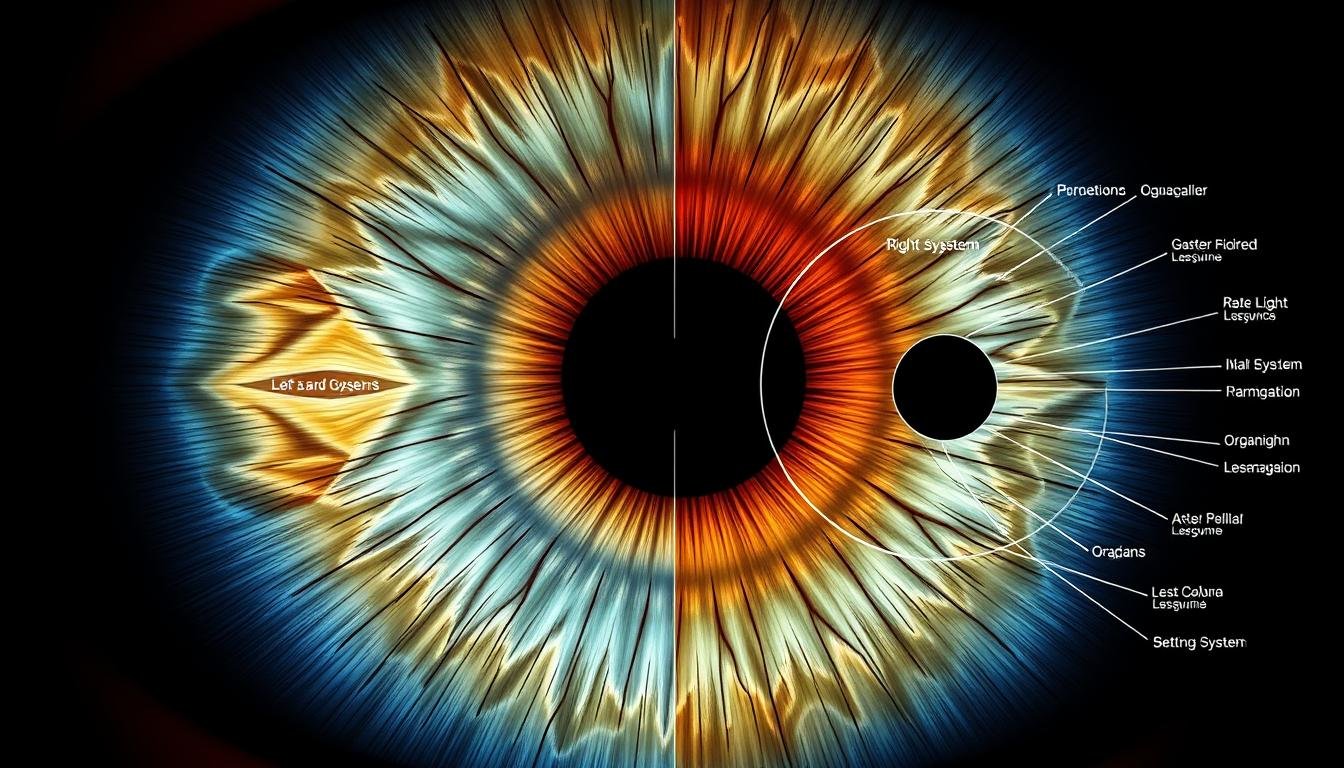
Un tableau d'iridologie standard cartographiant les zones de l'iris et les systèmes du corps
Un tableau d'iridologie serves as a map that divides the iris into multiple zones, each corresponding to specific organs and systems within the body. These charts are the foundation of iridology practice, allowing practitioners to analyze patterns, colors, and markings in the iris to assess potential health conditions and constitutional strengths or weaknesses.
The history of iridology charts dates back to the 19th century, with Hungarian physician Ignaz von Peczely often credited as developing the first systematic chart in the 1860s. The practice evolved through the work of Swedish homeopath Nils Liljequist and later practitioners who refined and expanded the mapping systems. Today, two primary schools of thought dominate the field: the European tradition and the American approach.
Iridologists use these charts to identify areas of concern by examining changes in iris structures, which they believe reflect the condition of corresponding body parts. While conventional medicine remains skeptical of iridology’s diagnostic capabilities, many alternative health practitioners continue to use these charts as complementary assessment tools.
Discover Your Iris Health Patterns
Curious about what your iris reveals about your health? Our experienced iridologists can provide a comprehensive analysis using both European and American chart systems.
Planifier une consultation
Key Differences Between European and American Graphiques d'iridologie
While both European and American iridologie systems aim to interpret iris signs, they differ significantly in their approach, historical development, and practical application. Understanding these differences is essential for anyone seeking to utilize iridology effectively.
European Tableau d'iridologie Méthodologie


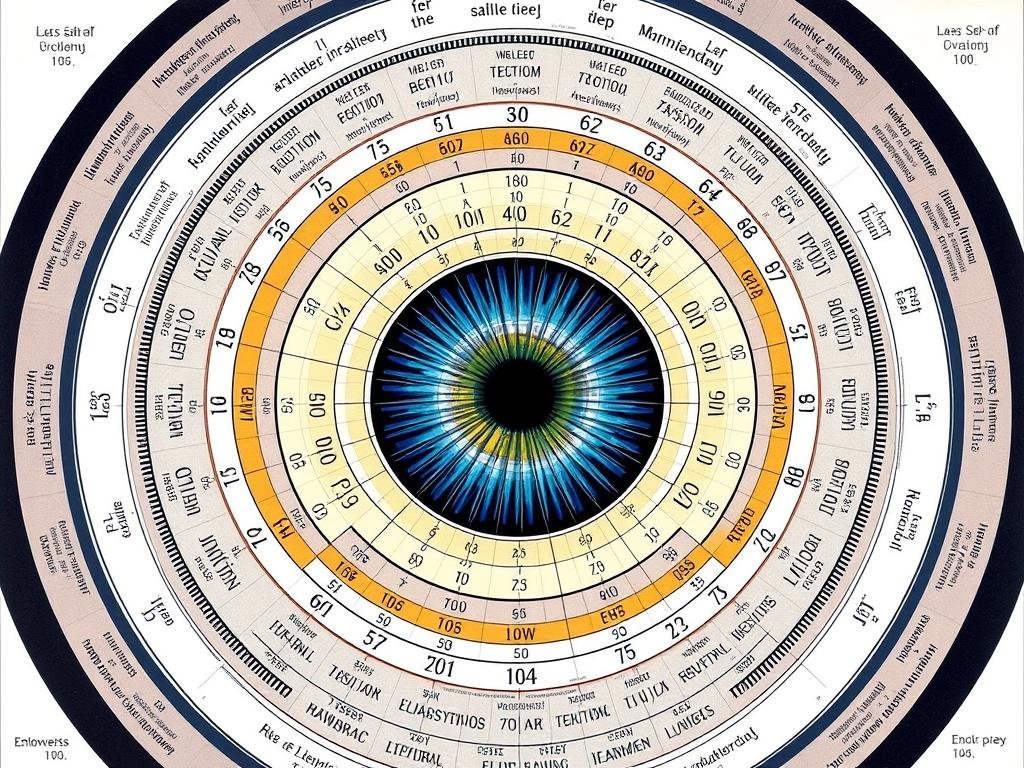
Traditional European iridology chart with concentric zone mapping
The European approach to iridology, particularly the German school, emphasizes constitutional assessment and tends to be more conservative in its health interpretations. European charts typically feature:
- More detailed topographical mapping with numerous subdivisions
- Greater emphasis on constitutional types and inherited traits
- Focus on tissue changes and layers within the iris
- More conservative interpretations regarding specific disease states
- Integration with traditional European natural medicine approaches
European practitioners often use the “ten zones” system, which divides the iris into concentric rings representing different tissue layers. This approach, pioneered by German naturopath Josef Deck, emphasizes the depth of markings rather than just their location. European charts also typically include detailed analysis of the collarette (autonomic nerve wreath) as a key diagnostic indicator.
American Tableau d'iridologie Méthodologie
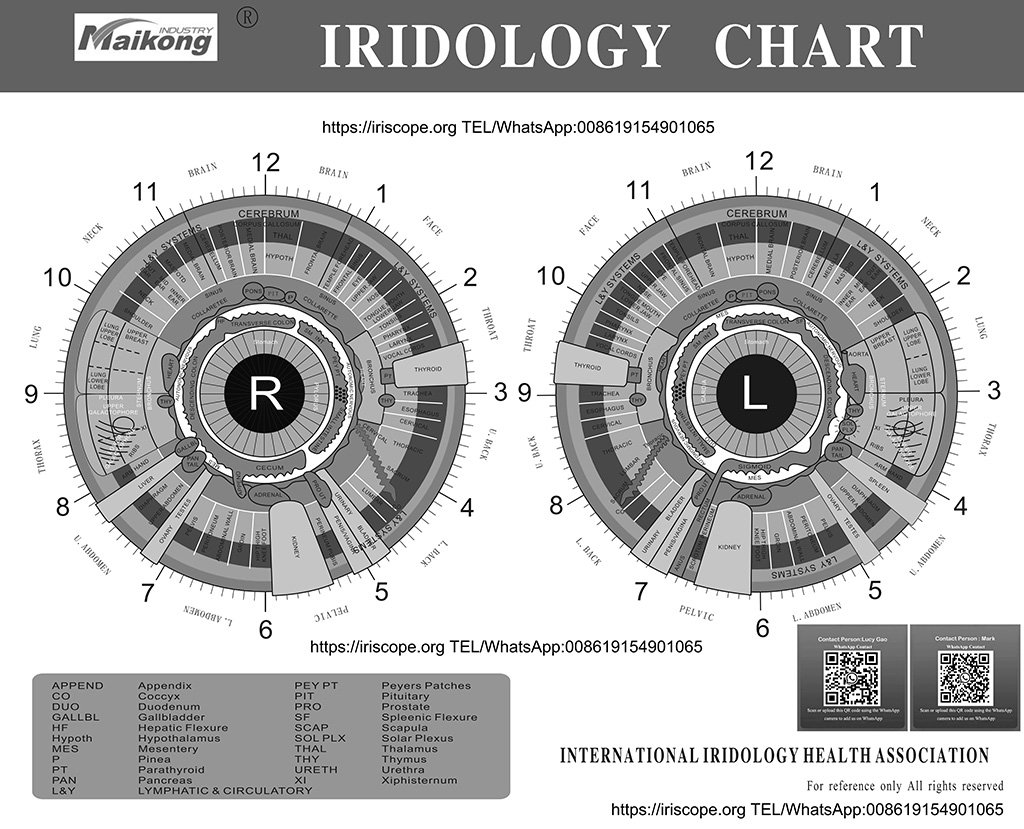
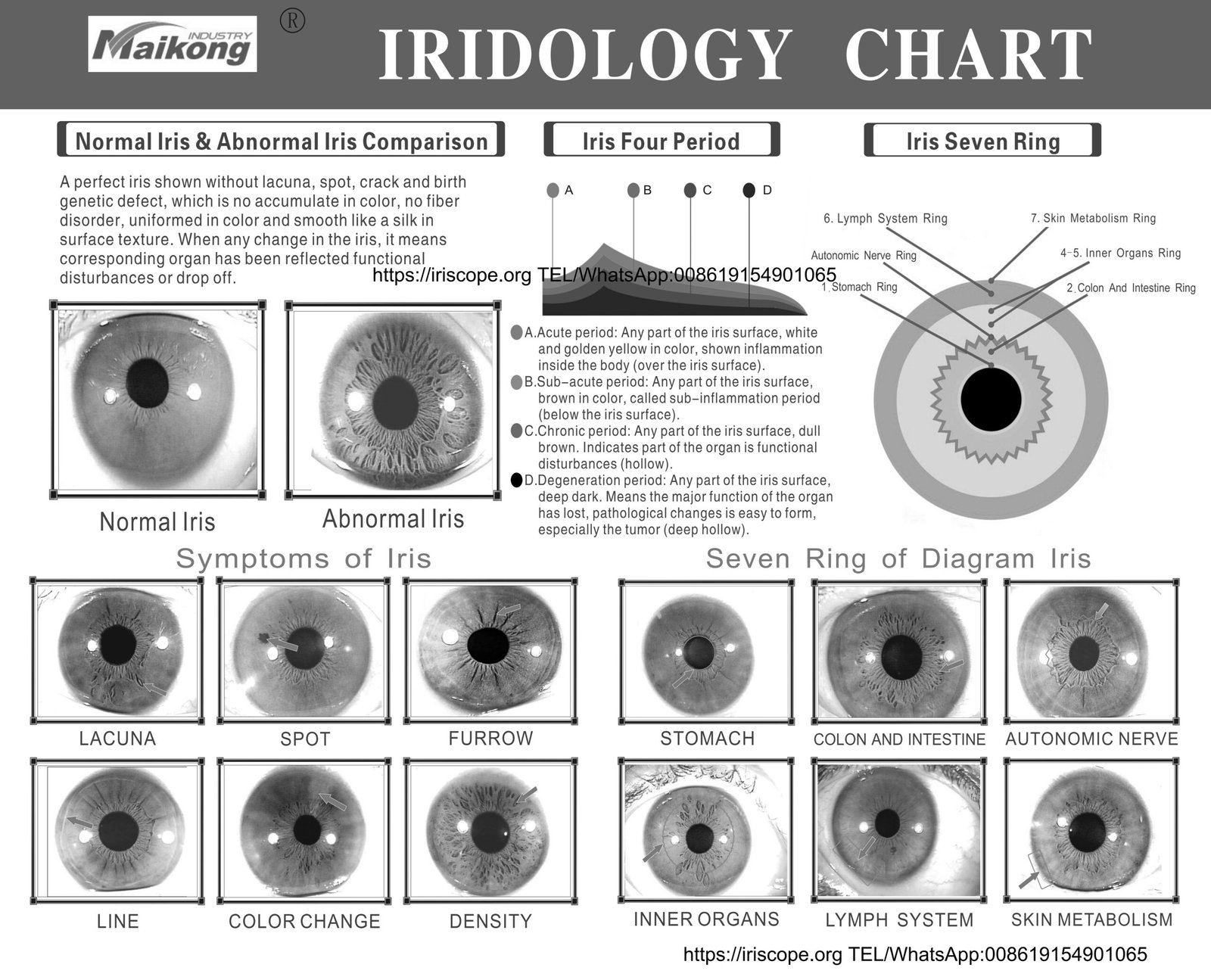
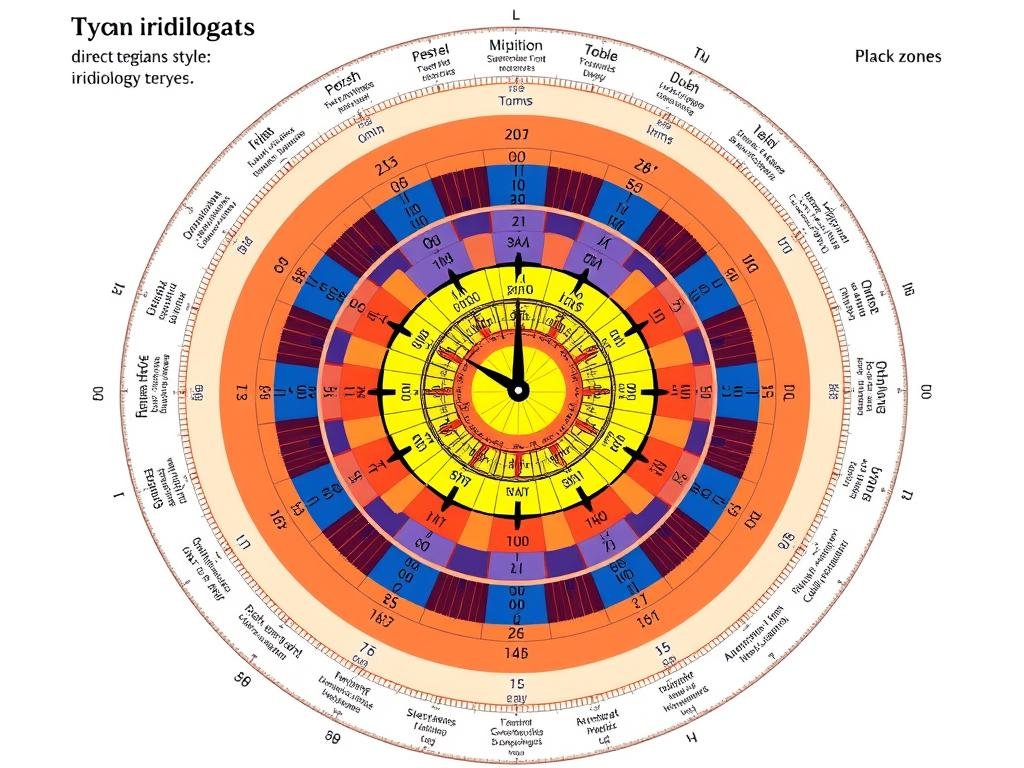
Modern American iridology chart with organ-specific mapping
The American approach, largely influenced by Bernard Jensen, tends to be more direct in correlating iris signs with specific organs and health conditions. American charts typically feature:
- Clock-face mapping system with simpler divisions
- More direct organ correlations
- Greater emphasis on nutritional and lifestyle factors
- Integration with chiropractic and naturopathic traditions
- More assertive interpretations regarding specific health conditions
American iridology often incorporates color analysis more prominently, with specific colors indicating different conditions or toxic accumulations. The Jensen approach divides the iris into seven concentric zones and eight pie-shaped sectors, creating a more straightforward mapping system than its European counterparts.
While European charts might focus on constitutional predispositions, American charts often aim to identify specific active health issues and their nutritional or therapeutic solutions.
Visual Comparison of Tableau d'iridologie Designs
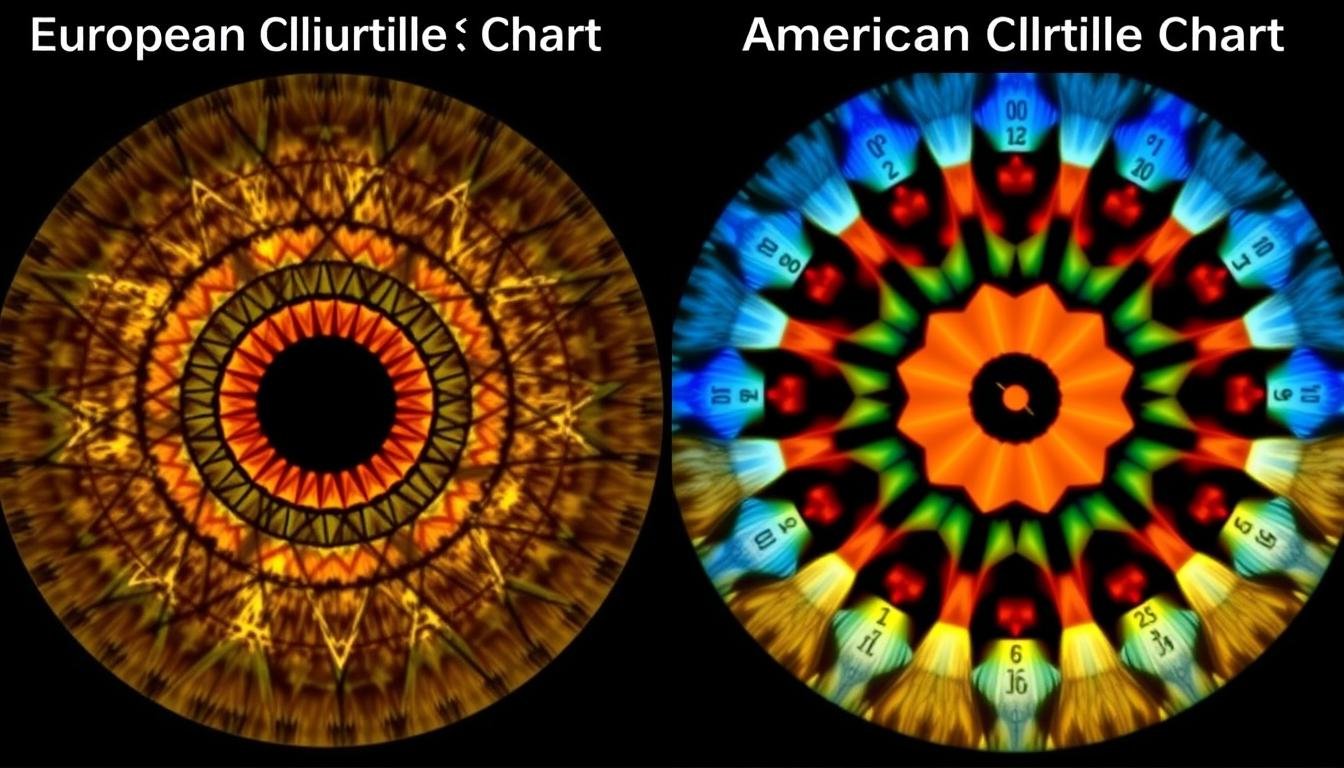
Side-by-side comparison of European (left) and American (right) iridology chart systems
| Fonctionnalité |
Graphiques européens |
Graphiques américains |
| Primary Division System |
Concentric zones (typically 10) |
Clock-face with 7 zones and 8 sectors |
| Interprétation des couleurs |
Subtle, focuses on constitutional types |
Bold, directly correlates to conditions |
| Tissue Layer Analysis |
Highly detailed, multiple layers |
Simplified, focuses on end organs |
| Terminology |
Often uses German/European terms |
Simplified English terminology |
| Approche diagnostique |
Évaluation constitutionnelle |
Specific condition identification |
| Treatment Integration |
Homeopathy, European biological medicine |
Nutrition, naturopathy, chiropractic |
The visual differences between European and American charts reflect their philosophical approaches. European charts tend to have more intricate divisions with subtle color gradations, while American charts often use bolder colors and clearer demarcations between zones.
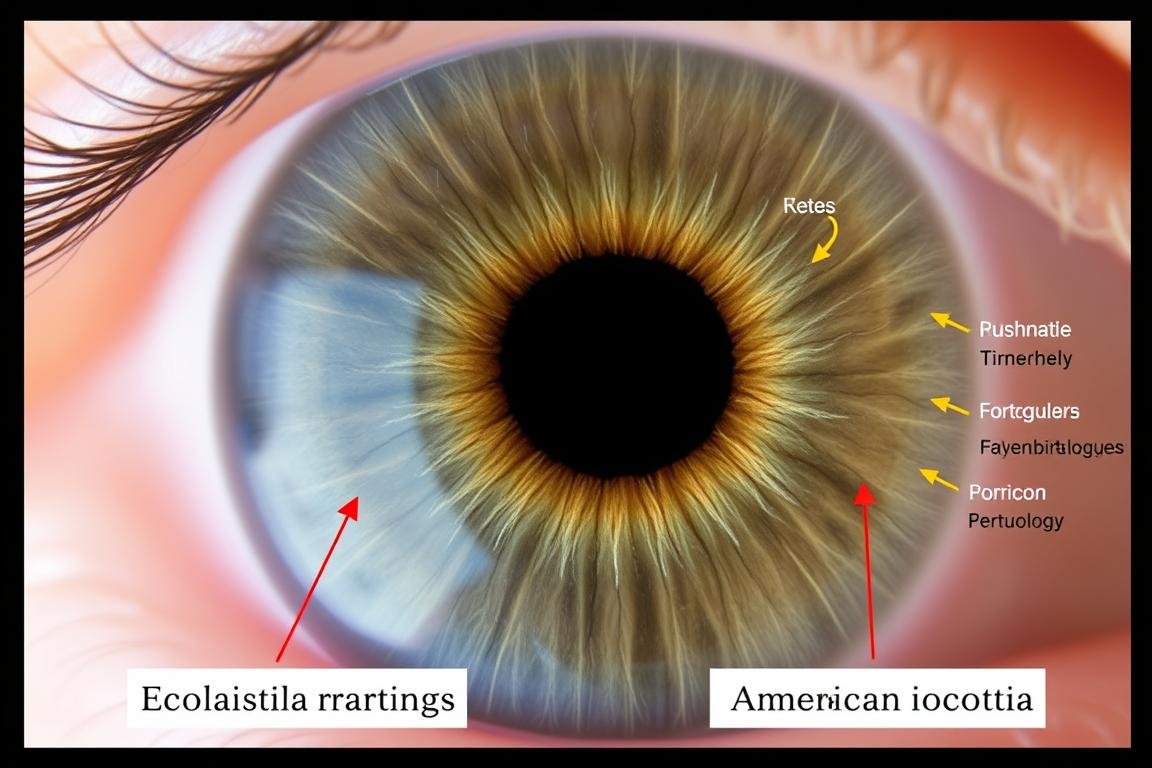
The same iris markings interpreted differently in European vs American systems
Symbol usage also varies between the two systems. European charts often employ more complex symbols to denote tissue changes, while American charts may use simpler, more intuitive symbols that directly suggest organ conditions.
How to Choose the Right Tableau d'iridologie for Your Practice
Selecting the appropriate iridology chart system depends on your background, goals, and the context in which you’ll be using iridology. Here are some considerations to help guide your choice:

Many modern practitioners incorporate elements from both European and American systems
Case Studies: European vs American Graphiques d'iridologie
Case Study 1: Preventative Health Screening
A naturopathic clinic in Switzerland used the European chart system to screen patients for constitutional weaknesses. The detailed tissue analysis allowed practitioners to identify inherited tendencies before symptoms manifested, enabling preventative protocols. The European system’s conservative approach prevented overdiagnosis while still providing valuable constitutional insights.
Case Study 2: Integrative Wellness Center
An American wellness center incorporated Jensen’s chart system to quickly identify potential areas of concern and integrate findings with nutritional protocols. The direct organ correlations allowed for immediate dietary and supplement recommendations. Clients reported the approach was accessible and provided actionable insights for their health journey.
Pros and Cons of Each Tableau d'iridologie Style
European Chart Advantages
- More detailed tissue analysis
- Better for constitutional assessment
- Stronger historical foundation
- More conservative claims reduce risk of overdiagnosis
- Well-integrated with European biological medicine
European Chart Limitations
- Steeper learning curve
- More complex terminology
- May be too conservative for some practitioners
- Less direct correlation to specific treatments
- Fewer English-language resources available
American Chart Advantages
- More intuitive, easier to learn
- Direct correlation to specific organs
- Better integration with nutritional therapy
- More English-language resources available
- Simplified system accessible to beginners
American Chart Limitations
- May oversimplify complex health conditions
- Risk of overinterpreting findings
- Less emphasis on constitutional factors
- Newer system with less historical foundation
- Some correlations may lack research validation
Many modern practitioners find value in learning both systems and integrating aspects of each approach. Your choice may also depend on your existing training in complementary health modalities – those with backgrounds in European biological medicine may prefer European charts, while those trained in American naturopathic traditions might find the American system more aligned with their practice.
Enhance Your Iridology Practice
Looking to deepen your understanding of different iridology chart systems? Our comprehensive training program covers both European and American methodologies.
Learn More About Training
Practical Application of Different Iridology Chart Systems

Modern digital iridology software often incorporates multiple chart systems for comprehensive analysis
Regardless of which chart system you choose, the practical application involves several key steps:
- Proper iris examination using adequate lighting and magnification
- Documentation of iris features through photography or detailed notes
- Mapping observed features to the appropriate zones on your chosen chart
- Interpretation of findings based on chart correlations
- Integration with other assessment methods for a comprehensive view
Modern technology has enhanced iridology practice through digital iris photography and specialized software that can overlay chart systems directly onto iris images. Some programs even allow toggling between European and American chart systems for comparative analysis.

Specialized equipment allows for detailed iris examination and documentation
It’s important to note that while iridology charts provide a framework for analysis, interpretation requires skill developed through practice and experience. The chart is merely a tool – the practitioner’s knowledge and clinical judgment remain essential to effective iridology practice.
FAQ À propos Graphiques d'iridologie
Which iridology chart system is more accurate?
Neither system can claim superior accuracy as both European and American iridology chart systems lack substantial scientific validation. The choice depends more on your practice style and background. European charts tend to be more conservative in their interpretations, while American charts may offer more direct correlations to specific conditions. Many practitioners find value in understanding both approaches.
Can I combine elements from both European and American iridology charts?
Yes, many modern practitioners take an integrative approach, using the constitutional assessment strengths of European charts alongside the more direct organ correlations of American charts. This hybrid approach can provide a more comprehensive analysis, though it requires thorough understanding of both systems to avoid contradictory interpretations.
How long does it take to become proficient in reading iridology charts?
Developing proficiency typically takes at least 6-12 months of dedicated study and practice. European charts generally have a steeper learning curve due to their more complex mapping and terminology. American charts may be more accessible to beginners but still require significant practice to interpret accurately.
Are digital iridology charts more accurate than traditional paper charts?
Digital charts offer advantages in precision and ease of use but aren’t inherently more accurate. The underlying mapping system (European or American) matters more than the format. Digital systems do allow for better documentation, magnification, and comparison over time, which can enhance the overall assessment process.
Do iridology charts work for all eye colors?
Both European and American chart systems can be applied to all eye colors, though darker irises may require more specialized equipment for proper examination. European charts often include more detailed guidance for interpreting different constitutional eye colors, while American charts tend to focus more on markings regardless of base color.
What scientific evidence supports iridology chart mapping?
Conventional medicine does not recognize iridology as a validated diagnostic method, and controlled studies have not demonstrated consistent correlations between iris signs and health conditions. Both European and American chart systems are based primarily on observational case studies rather than controlled research. Practitioners view iridology as a complementary assessment tool rather than a definitive diagnostic method.
Can iridology charts detect specific diseases?
Neither European nor American iridology charts claim to diagnose specific diseases. European charts tend to identify constitutional tendencies and tissue weaknesses, while American charts may correlate findings with functional imbalances in specific organs. Responsible practitioners use iridology as one component of a comprehensive health assessment, not as a standalone diagnostic tool.
How do iridology charts account for changes in the iris over time?
The fundamental structure of the iris remains relatively stable throughout life, which contradicts some iridology principles. European charts tend to focus more on constitutional patterns present from birth, while American charts may interpret certain changes as reflections of developing health conditions. Modern practitioners often document iris appearance over time to observe potential changes, though significant structural changes are rare.

A comprehensive iridology reference library often includes multiple chart systems for comparative study
Conclusion: Integrating Iridology Chart Knowledge
The choice between European and American iridology chart systems ultimately depends on your specific goals, background, and practice context. European charts excel in constitutional assessment and offer a more conservative approach with detailed tissue analysis. American charts provide more direct organ correlations and integrate well with nutritional therapy approaches.
Many modern practitioners find value in understanding both systems, allowing them to draw from the strengths of each approach. As with any complementary health assessment method, iridology is most effective when used as one component of a comprehensive evaluation rather than in isolation.
Whether you’re a health practitioner considering incorporating iridology or simply curious about this fascinating assessment method, understanding the differences between chart systems provides valuable context for further exploration.

The future of iridology may lie in integrating the best aspects of different chart systems
Deepen Your Iridology Knowledge
Ready to explore iridology further? Our expert practitioners can help you understand which chart system best suits your needs and provide personalized guidance.
Schedule Your Consultation Today


























